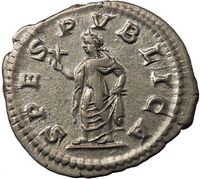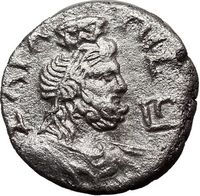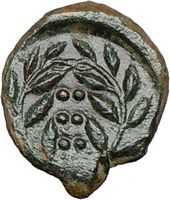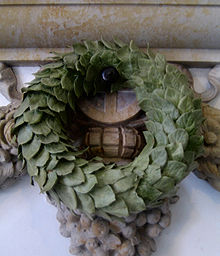Plants, Fruits and Grains on Ancient Greek and Roman Coins
It is interesting to see the imagery of plants on various different ancient Greek and Roman coins, which you can see here. Plants played an important role in their lives and were depicted often on ancient coins. Some of the meanings they had were abundance, success, well-being, fertility and more. This article explores the various imagery seen on ancient coins. You can see the various depictions by clicking on the coins in this article.

François-Xavier Fabre, c. 1808
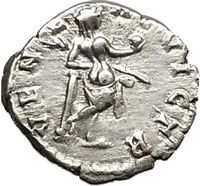
The apple that Venus holds is the golden prize apple winning the contest between the other goddesses for winning the award for being the "fairest one". There is also the palm branch she holds, which symbolized victory and is a symbol often used on ancient coins. Read more about the Judgment of Paris here
 The olive branch of
Pax, the goddess
of peace, holds the olive branch that symbolized peace.
The olive branch of
Pax, the goddess
of peace, holds the olive branch that symbolized peace.
In Roman mythology, Pax [paqs] (Latin for peace) (her Greek equivalent was Eirene) was recognized as a goddess during the rule of Augustus. On the Campus Martius, she had a temple called the Ara Pacis, and another temple on the Forum Pacis. She was depicted in art with olive branches, a cornucopia and a scepter. There was a festival in her honor on January 3. Daughter of Jupiter and Iustitia. Pax was often associated with spring.
The Goddess of hope, Spes holds the flower on coins where she is depicted.
In ancient Roman religion, Spes was the goddess of hope. Multiple temples to Spes are known, and inscriptions indicate that she received private devotion as well as state cult.
During the Republic, a temple to "ancient Hope" (Spes vetus) was supposed to have been located near the Praenestine Gate. It was associated with events that occurred in the 5th century BC, but its existence as anything except perhaps a private shrine has been doubted. A well-documented temple of Spes was built by Aulus Atilius Calatinus along with Fides, as the result of vows (vota) made to these goddesses during the First Punic War.At Capua in 110 BC, a temple was built to the triad of Spes, Fides, and Fortuna.
Spes was one of the divine personifications in the Imperial cult of the Virtues. Spes Augusta was Hope associated with the capacity of the emperor as Augustus to ensure blessed conditions.
Rhodes the ancient Greek island city, depicted the rose on their coins.
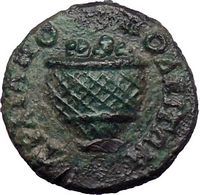
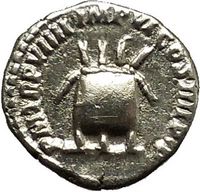 Fruits
were depicted on ancient coins also. Interesting to note how more modern artists
of our times, still draw fruits to this day!
Fruits
were depicted on ancient coins also. Interesting to note how more modern artists
of our times, still draw fruits to this day!
Modius - the ancient Roman units of measurement were built on the
Hellenic system
with
Egyptian,
Hebrew,
and
Mesopotamian
influences. The
Roman
units were
comparatively consistent and well documented.
Serapis would be depicted with a modius on top of his head.
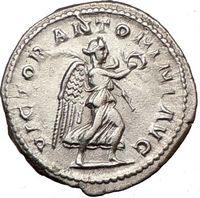 Victory
the ancient Roman goddess, personifying victory, the Roman parallel to Nike
Victory
the ancient Roman goddess, personifying victory, the Roman parallel to Nike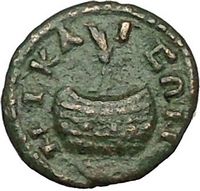
She is often depicted with the palm branch, which is a symbol of victory. The branch is depicted on coins including olympic-style athletic games, prize urns.
The wreath that is depicted is a usually laurel, and is at times of oak.
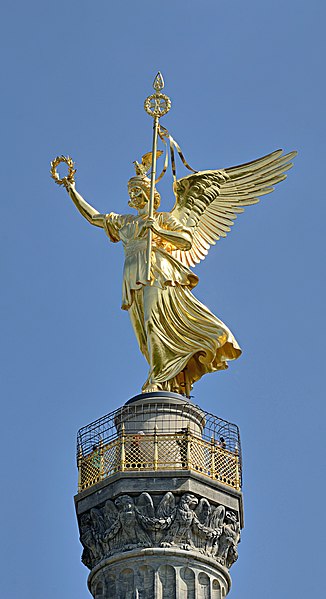 The
wreath was a symbol of victory in ancient Greek and Roman times, and references
to it are still used in modern English language, as some may term it to be a
"victory wreath." A
laurel wreath,
oak wreath or wreath is a circular
wreath made of interlocking branches and leaves
of the
bay laurel (as in laurel wreath) (Laurus
nobilis,
Lauraceae), an aromatic broadleaf evergreen; or
branches and leaves of other plants. In
Greek mythology,
Apollo is represented wearing a laurel wreath
on his head. A wreath made of oak has connections to Jupiter, the Roman
equivalent of Zeus, as his sacred tree was the oak. In
ancient Greece wreaths were awarded to victors,
both in athletic competitions, including the ancient
Olympics made of wild olive-tree known as "kotinos"
(κότινος), (sc. at
Olympia) and in poetic meets; in
Rome they were symbols of martial victory,
crowning a successful commander during his
triumph.
The
wreath was a symbol of victory in ancient Greek and Roman times, and references
to it are still used in modern English language, as some may term it to be a
"victory wreath." A
laurel wreath,
oak wreath or wreath is a circular
wreath made of interlocking branches and leaves
of the
bay laurel (as in laurel wreath) (Laurus
nobilis,
Lauraceae), an aromatic broadleaf evergreen; or
branches and leaves of other plants. In
Greek mythology,
Apollo is represented wearing a laurel wreath
on his head. A wreath made of oak has connections to Jupiter, the Roman
equivalent of Zeus, as his sacred tree was the oak. In
ancient Greece wreaths were awarded to victors,
both in athletic competitions, including the ancient
Olympics made of wild olive-tree known as "kotinos"
(κότινος), (sc. at
Olympia) and in poetic meets; in
Rome they were symbols of martial victory,
crowning a successful commander during his
triumph.
The wreath symbol was used often on ancient Greek and Roman coins. The wreath on ancient Roman coins is often depicted being held by Jupiter's (Zeus') sacred bird, the eagle, and also Victory (Nike) and by other deities less often; and many coins with emperors depicted wearing it; and at times, entire designs being surrounded by a wreath.
In common modern idiomatic usage it refers to a victory. The expression "resting on one's laurels" refers to someone relying entirely on long-past successes for continued fame or recognition, where to "look to one's laurels" encourages an individual to take inspiration from past achievements to conquer a fresh task.
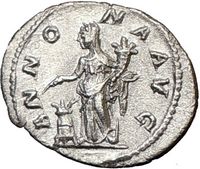 Annona
the ancient Roman goddess of agriculture
Annona
the ancient Roman goddess of agriculture
Annona (from Latin annus, year), in Roman mythology, is the personification of the produce of the year. She is represented in works of art, often together with Ceres, with a cornucopia (horn of plenty) in her arm, and a ship's prow in the background, indicating the transport of grain over the sea. She frequently occurs on coins of the empire, standing between a modius (corn-measure) and the prow of a galley, with ears of corn in one hand and a cornucopia in the other; sometimes she holds a rudder or an anchor.
There is also the goddess Ceres that is depicted on ancient coins, her Greek equivalent was Demeter
In
ancient Roman religion,
Ceres
was a
goddess of agriculture,
grain crops, fertility and motherly
relationships. Her cult took many forms. She was the central deity in Rome's
so-called plebeian or
Aventine Triad, and
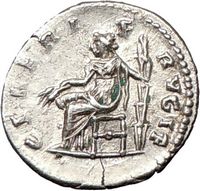 was
paired with her daughter
Proserpina in what Romans described as "the
Greek rites of Ceres". She played an essential role in Roman marriage and in
funeral rites. Her seven-day April festival of
Cerealia included the popular
Ludi Ceriales (Ceres' games). She was honoured in the May
lustration of fields at the
Ambarvalia festival, and at harvest-time. Her
functions and cults were held equivalent to those of the Greek goddess
Demeter, whose
mythology she came to share.
was
paired with her daughter
Proserpina in what Romans described as "the
Greek rites of Ceres". She played an essential role in Roman marriage and in
funeral rites. Her seven-day April festival of
Cerealia included the popular
Ludi Ceriales (Ceres' games). She was honoured in the May
lustration of fields at the
Ambarvalia festival, and at harvest-time. Her
functions and cults were held equivalent to those of the Greek goddess
Demeter, whose
mythology she came to share.
In Greek mythology, Demeter was the goddess of the harvest, who presided over grains, the fertility of the earth, the seasons (personified by the Hours), and the harvest. One of her surnames is Sito (σίτος: wheat) as the giver of food or corn. Though Demeter is often described simply as the goddess of the harvest, she presided also over the sanctity of marriage, the sacred law, and the cycle of life and death. She and her daughter Persephone were the central figures of the Eleusinian Mysteries that also predated the Olympian pantheon.
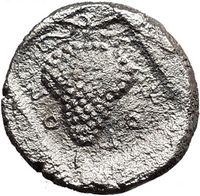 Grapes
were depicted on many ancient coins, which were connected to the gods
Dionysus who is often depicted holding them.
Grapes
were depicted on many ancient coins, which were connected to the gods
Dionysus who is often depicted holding them.
There is also a cornucopia, or the horn of plenty, a symbol of wealth which is seen being held by various different gods and goddesses. One of the goddesses is Abundantia, the goddess of abundance.
The cornucopia (from Latin cornu copiae) or horn of plenty is a symbol of abundance and nourishment, commonly a large horn-shaped container overflowing with produce, flowers, nuts, other edibles, or wealth in some form. Originating in classical antiquity, it has continued as a symbol in Western art, and it is particularly associated with the Thanksgiving holiday in North America.
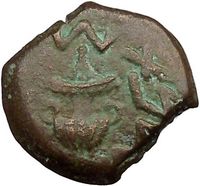
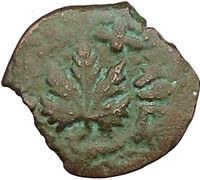 This
interesting coin of the
Jewish people of
Jerusalem, circa 69-70 A.D., depicts the Amphora which holds goods, such as
olive oil, whine, et cetera and the vine leaf, for the wine which was important
to their religious ceremonies.
This
interesting coin of the
Jewish people of
Jerusalem, circa 69-70 A.D., depicts the Amphora which holds goods, such as
olive oil, whine, et cetera and the vine leaf, for the wine which was important
to their religious ceremonies.
![]() Download this article by right-clicking here and selecting save as
Download this article by right-clicking here and selecting save as
